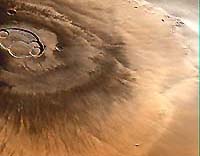In the January 25, 2002, issue of Nature, researchers from the Massachusetts Institute of Technology, the University of Tennessee and other institutions report that evidence from a Martian volcanic rock indicates that Mars magmas contained significant amounts of water before eruption on the planet's surface.

|
Scientists have found that channels on Mars's surface may have been carved by flowing water and an ancient ocean may have existed there, but little was known about the source of the water. One possible source is volcanic degassing, in which water vapor is produced by magma spewing from volcanoes, but the Martian rocks that have reached Earth as meteorites have notoriously low water content.
When magma reaches the planet's surface, the solubility of water in the molten liquid decreases and the water forms vapor bubbles and escapes as gas. The process is similar to the release of gas bubbles that occurs when you open a can of soda.
Although this doesn't explain how water got into Mars in the first place, it does show that water on the red planet once cycled through the deep interior as well as existed on the surface, as similar processes have cycled water through the Earth's interior throughout geologic history.
Authors on the Nature paper include McSween's graduate student, Rachel C. F. Lentz; Lee R. Riciputi of the chemical and analytical sciences division of Oak Ridge National Laboratory; Jeffrey G. Ryan, a geologist at the University of South Florida; and Jesse C. Dann and Astrid H. Holzheid of MIT's Department of Earth, Atmospheric and Planetary Sciences. The work was partly supported by NASA.